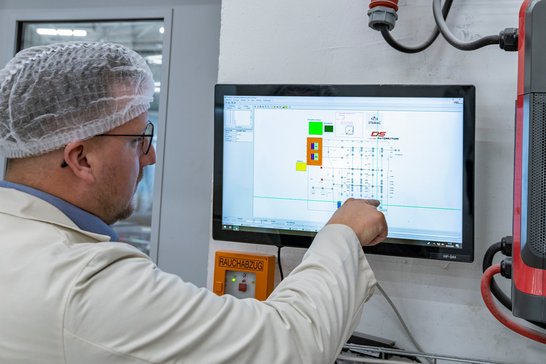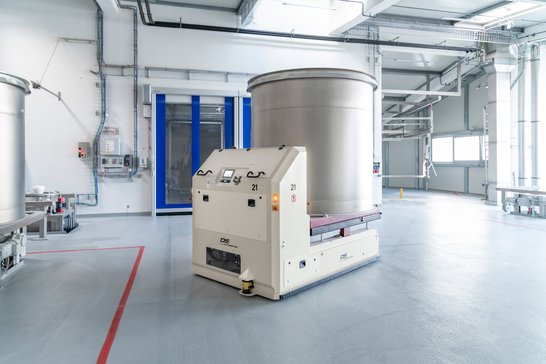As a leading manufacturer of malts and baking ingredients, STAMAG Stadlauer Malzfabrik GesmbH is an im-portant partner for breweries and bakeries. Its glass baking ingredient factory in Vienna enables the flexible and hygienic composition of baking mixes according to around 400 recipes. Two driverless transport systems from DS Automotion form the backbone of the production facility, which will open in 2023. A freely navigating sys-tem with model-predictive route calculation in production ensures maximum flexibility and process reliability, while another ensures the rapid availability of cleaned batch containers for assembling the next batch.
Share article

Consumers expect to find a wide range of different bakery and confectionery products in bakeries and retail outlets, varied and fresh at any time of day. This was not possible when bread and pastries were still made by hand in the bakery early in the morning in small quantities for the day's requirements. Today, baked goods are produced with high efficiency, process stability, hygiene and traceability in centralized bakeries. Only products that quickly lose their freshness undergo the actual baking process as the final step in the store. Only in this way can baked goods be produced in large quantities at consumer-compatible prices in consistently high quality and offered fresh throughout the day.
Baking ingredients from Vienna
In order to have time for creativity and the development of an individual touch with this combination of quantity and variety, bakeries use the advantages of high-quality baking ingredients. STAMAG Stadlauer Malzfabrik GesmbH is the leading Austrian bakery ingredient manufacturer. Founded in 1884 and based in Vienna, the company supplies numerous Central European breweries with malt and produces various malt derivatives. These included malt coffee from 1892 and Ovomaltine from 1916.
With the invention of the diastatic malt extract "DIAMALT" at the beginning of the 20th century, the company succeeded in creating a baking agent used worldwide for white bread production and thus entered the baking ingredients business. This was followed by swelling flours such as RISOFARIN and dough leavening agents such as PROTOSAUER, which are still among the mainstays of the product portfolio today. This has been supplemented by confectionery ingredients since 1961. As a total supplier, STAMAG manufactures around 800 different products for bakeries and confectioners, as well as for the catering and communal catering sectors.
Baking mixes from the glass factory
STAMAG is part of the German family-owned company IREKS GmbH. In line with the slogan "Committed to good tradition, dedicated to real progress", the company continuously reinvests its profits in the eco-logization, renewal and expansion of its facilities. This also includes the Gläserne baking ingredients factory, which opened in 2023. It enables the particularly flexible production of baking ingredients.
STAMAG mixes these according to around 400 recipes from predominantly dry and free-flowing ingredients. Not least because of the wide and dynamically growing range of gluten-free trend products, production does not take place on permanently installed mixing lines using the batch method, which offers little flexibility during the process.
Flexibility and hygiene through mobile robotics
At the parent company IREKS in Kulmbach (Bavaria), a driverless transport system (DTS) from DS AUTOMOTION has been enabling flexible, equalized processes for the production of baking ingredients since 1998. Its mobile robots transport the containers in the correct sequence to more than 220 removal points, where the ingredients are transferred by gravity directly from the silos into the containers and then on to the mixing station. This means that the entire production of each product batch, from dosing the individual components to mixing and delivery to the bagging system, takes place within a single container.
"With this system, new or modified recipes can be implemented quickly and easily by programming a new route," says Gerhard Gregor Podertschnig, Head of Baking Ingredient Production at STAMAG. "In addition, route planning is automated based on the order data from the MES system and takes into account the different loading times of the individual ingredients." It was therefore an obvious choice to use a similar system from the same manufacturer for the construction of the glass bakery ingredient factory.
Production at level 0
The empty containers from the high-bay warehouse are transferred to three AGVs on level 0 via several chain conveyors. The fleet manager communicates with the conveyor system via OPC UA. Task-specific mobile robots developed by DS AUTOMOTION are used with a height-adjustable roller conveyor, a digital weighing cell and a mechanism for opening and closing the container lid.
They navigate freely to the removal points on the ceiling using dead reckoning with magnetic points. There they remove the lid of the container and lift it so that it docks dust-tight at the removal point. The fleet manager reports to the dosing system's control computer that it is ready for dosing and that the expected component weight has been reached.

The vehicles are equipped with their own visualization including display of the integrated weighing and the actual vehicle positions and statuses are displayed in real time in a graphical system layout at the control station. This visualization is web-based and can therefore also be displayed on other computers or handheld devices.
Optimal navigation in checkerboard pattern
Their differential drive enables the mobile robots to turn on the spot and move like the tower on a chessboard. Their thin plate pure lead (TPPL) batteries are charged by means of contacts attached to the side of the robot while it remains at the manual dispensing positions. Based on the order data from the MES system and known parameters such as the time required for the individual dispensing processes, which varies greatly from 5 to 40 minutes, and their sequence, the control system calculates a model of the future vehicle positions.
Container cleaning on level 2
The storage and retrieval unit of the high-bay warehouse then takes the batch containers to level 2, where they are picked up by mobile robots. These robots drive under the containers, lift them and take them to one of four emptying stations. After the residual quantities have been emptied, they are transported by the same AGVs to dry cleaning and then back to the high-bay warehouse.
The vehicles, which are also customized, differ from those on level 0. They are designed with a three-point chassis and a lifting table for driving directly under the containers. They have a maximum load capacity of 2,500 kg and transport both empty and full containers. Like the vehicles on level 0, they are also equipped with TPPL batteries, which are recharged via contacts during breaks. The content of the visualization system attached directly to the vehicle can also be transferred to the terminal or a smartphone. This enables interventions regardless of location.
Smooth implementation despite changes
Structural changes were made during the implementation phase. These also affected the arrangement of the component silos and therefore had an impact on the routes to be stored. In addition, the interaction with the numerous conveyor systems and the high-speed doors from various manufacturers made it necessary to operate a large number of external interfaces.
Nevertheless, the AGV system was implemented within the targeted time frame. Since then, the complex system has been running smoothly. Nevertheless, Gerhard Gregor Podertschnig finds it reassuring to be able to fall back on direct, competent support from DS AUTOMOTION if required. "The Transparent Baking Ingredients Factory, which was realized using two AGV systems from DS AUTOMOTION, helps us to secure our leading market position with efficiency and flexibility advantages," concludes the STAMAG production manager.


![[Translate to English (Great Britain):] [Translate to English (Great Britain):]](/fileadmin/_processed_/d/0/csm_segal_2445931752.jpg)